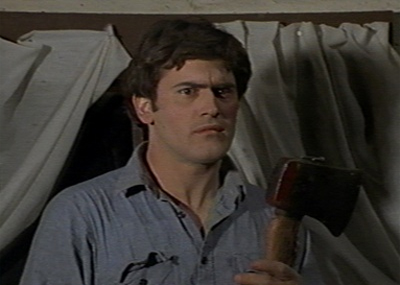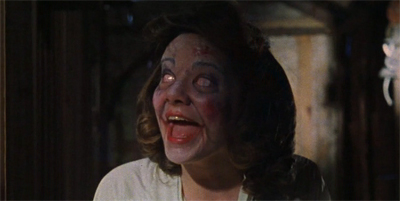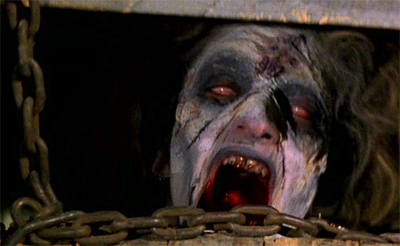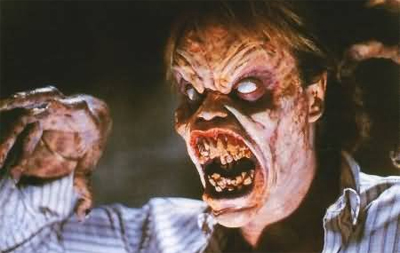This is a post as part of “Raimi-fest”, the event being organised by the always wonderful Bryce over at Things That Don’t Suck.
Sam Raimi’s original Evil Dead is actually a pretty decent addition to the zero-budget teens-go-up-to-the-woods-today-and-are-sure-of-a-big-surprise subgenre. It’s a trashy horror which demonstrates a deeper affinity for the genre than a lot of other “video nasty” slasher films are prone to. However, while the film displays clear hints of the director’s developing skill, it still feels just a little bit too much like another random exploitation “schlock and shock” film.
In fairness to Raimi, the movie feels like something of an affectionate homage to those gory little pictures that were very common at the time (and remain quite common today, in their own form). The plot devices and atmospheric moments are all borrowed wholesale from similar features, but Raimi’s little horror has a hint of self-awareness about it (even if the characters don’t). We know, for instance, that a bunch of teenagers in an abandoned cabin are really just asking for some sort of apocalyptic event – just as we accept the hokey recordings of a rambling history professor captured on tape will provide (not especially necessary) exposition.
However, it’s how Raimi uses these devices which mark him out – even here – as a talent to watch. We’re all familiar with the devices which spell doom for your young cast, those little indicators of things to come – and Raimi executes them with skill. There is, for example, something exceedingly creepy about a wooden swing-bench beating repeatedly against an old wooden shack – almost as creepy as when it mysteriously stops. The sound of voices whispering ominous chants like “join us” on the wind add to a heavy sense of dread.
In rewatching the trilogy, it’s remarkable how much Raimi seems to dislike establishing mood or atmosphere – this is the only film of the set which bothers with set-up. Despite an incredibly brief recap from the start of the events seen here (with the cast reduced to two), the sequel jumps right into the action. The third movie just takes its core concept and runs with it. By way of contrast, this film takes a good half-an-hour to set up what is to come – peppering scenes with hints of a demonic force at work. Check out that opening shot of the camera zooming over the surface of a lake, like a low-rent version of The Shining.
It probably wouldn’t have worked as well a second time, and this sort of “ramping up” can be a pain if executed poorly (as it is in the vast majority of films), but those opening sequences effectively create a sense of dread in the audience. Raimi’s cast are about as bland as any other random bunch of teenagers on the verge of a horrific night (even Ash is not yet the man he would be), but there are some wonderful compositions and little touches which indicate that the director knows what he’s doing, even when not veering into ridiculously over-the-top cartoon antics.
Being honest, there are moments here when the film feels just a little bit too trashy or exploitational for its own good – as if the cast and crew are trying to push the boundaries of what they can get away with, just for the sake of pushing the boundaries. I enjoy the following two films, but I’ve never really embraced the idea of gore for its own sake. In the sequels, fountains of blood would rain down at the drop of a hat, pushing things well into the realms of self-parody, but there are moments here which don’t seem to share that sense of self-awareness.
The most obvious example, of course, is the infamous “tree rape” sequence – the moment that led Mary Whitehouse to compaign (successfully) to ban the film in England and a piece of footage that Raimi himself admits to regretting today. Perhaps it’s the fact that movie is played as a straight horror with hints of dark comedy, but there are other moments which seem, perhaps, a bit “too much” – like the loving detail of various parts of the Deadites’ anatomies exploding as we reach the climax. It’s all rendered in surprisingly loving detail (ooh! look! an intestine!) rather than the sheer ridiculous fountains of blood that we’d see in the movies to follow.
Still, even here, in the first of the trilogy – where things are played as genuine horror rather than grotesque comedy – there are hints of Raimi’s demented sense of humour at play. Consider, for example, the matter of fact way that the recording suggests “the act of bodily dismemberment” as a way of dealing with the demonic spirits (it might as well have said “you’re gonna need that axe”). However, things never get too light or campy – there are some wonderfully dark sequences in there. My personal favourite terrifying sequence from the film (and one which did give me nightmares at the time) is the point at which the cottage itself starts bleeding (through wall sockets and pipes).
And then there’s the Deadites themselves. Here they have more personality than any of the characters who still have a pulse. There’s something genuinely creepy (both here and in the direct sequel) about their manic laughter and destructive glee. Raimi skilfully creates the illusion – which is perhaps more terrifying than the actions themselves – that these evil creatures are actually enjoying the act of screwing with Ash and his friends more than anything else. There’s a sense that, with their hazily-defined characteristics, powers and weaknesses, that they could easily overwhelm and take the cabin – but they are simply toying with our leads because it’s just so damn fun.
I don’t know about you, but, to me, that’s more terrifying than the traditional “needs a host” or “trying to escape hell” motivations that films like this usually trot out. It also adds a bit of depth to the film, as compared to the majority of other similar horrors. Most obviously, the protagonists don’t seem to be just fighting for their lives – they are fighting for their sanity. There’s something genuinely creepy about the scenes of Ash talking to himself, mumbling after being subjected to the horrors of the night in the cabin – it seems almost like the demons don’t simply want to kill or consume our cast, but break them.
Compared to the two films that would follow, Evil Dead is perhaps a very conventional film. It’s a high-quality exploitation horror film, but it’s still an exploitation horror film. Although there are slight hints of the director that Raimi would become, there’s no real indication that this film couldn’t, for example, have been handled by Wes Craven (who was such a fan, he hid a reference to it in Nightmare on Elm Street). Over the course of the two films that would follow, Raimi would better define his own tone and voice – to the point where the films became much harder to pin down and classify.
Filed under: Non-Review Reviews | Tagged: Ash Williams, bruce campbell, Bryce, england, evil dead, film, films, horror, Horror film, Mary Whitehouse, Movies, non-review review, review, sam raimi, schlock, shining, spider man, video nasty, wes craven |

























This first installment was heavier on the scares than the subsequent films, for sure, but (even at this stage) Raimi was already laying the humor on pretty thick.
It is true that Wes Craven could have likely handled “Evil Dead,” and to a similar result. Then again, his own work – “Scream” and its sequels, for example – are also comedic and highly referential.